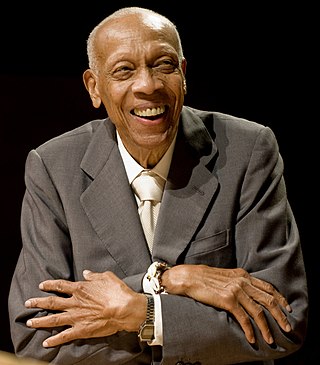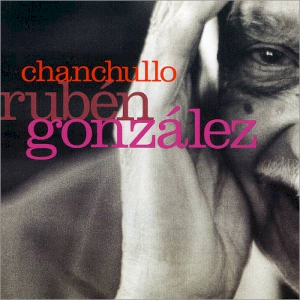Related Research Articles

Panart was one of the first and most successful independent record labels in Cuba, founded in 1944 by engineer Ramón Sabat. In 1961, its studios were seized by Fidel Castro's communist regime and the label was nationalized, becoming "Panart Nacionalizada", which shortly after was absorbed by EGREM.

Rubén González Fontanills was a Cuban pianist. Together with Lilí Martínez and Peruchín he is said to have "forged the style of modern Cuban piano playing in the 1940s".

Jesús Valdés Rodríguez, better known as Chucho Valdés, is a Cuban pianist, bandleader, composer and arranger whose career spans over 50 years. An original member of the Orquesta Cubana de Música Moderna, in 1973 he founded the group Irakere, one of Cuba's best-known Latin jazz bands.
A descarga is an improvised jam session consisting of variations on Cuban music themes, primarily son montuno, but also guajira, bolero, guaracha and rumba. The genre is strongly influenced by jazz and it was developed in Havana during the 1950s. Important figures in the emergence of the genre were Cachao, Julio Gutiérrez, Bebo Valdés, Peruchín and Niño Rivera in Cuba, and Tito Puente, Machito and Mario Bauzá in New York. Originally, descargas were promoted by record companies such as Panart, Maype and Gema under the label Cuban jam sessions. From the 1960s, the descarga format was usually adapted by large salsa ensembles, most notably the Fania All-Stars.
EGREM is the national record label of Cuba. It is headquartered in Centro Habana, where its main record studios operate. It was founded in 1964 after the nationalization of the Cuban music industry, absorbing the assets of Panart. EGREM had a monopoly on music production activities from 1964 until the late 1980s when independent labels reemerged. EGREM's archive comprises "the most extensive catalog of Cuban music in the world".

Dionisio Ramón Emilio Valdés Amaro, better known as Bebo Valdés, was a Cuban pianist, bandleader, composer and arranger. He was a central figure in the golden age of Cuban music, especially due to his big band arrangements and compositions of mambo, chachachá and batanga, a genre he created in 1952.

Israel López Valdés, better known as Cachao, was a Cuban double bassist and composer. Cachao is widely known as the co-creator of the mambo and a master of the descarga. Throughout his career he also performed and recorded in a variety of music styles ranging from classical music to salsa. An exile in the United States since the 1960s, he only achieved international fame following a career revival in the 1990s.

Candelario Orlando López Vergara, better known as Cachaíto, was a Cuban bassist and composer, who gained international fame after his involvement in the Buena Vista Social Club recordings. He was nicknamed Cachaíto after his uncle, the famous bassist and innovator of mambo music Israel "Cachao" López. His father and Cachao's older brother was Orestes López, also a famous bassist/multi-instrumentalist and composer.
Orestes López Valdés, nicknamed Macho, was a Cuban multi-instrumentalist, composer and bandleader. As a double bassist he was a founding member of the Havana Philharmonic Orchestra, and later a member of the National Symphony Orchestra of Cuba. A long-time member of the charanga Arcaño y sus Maravillas, where he played cello and piano, he is considered the co-creator of the mambo, together with his brother Israel "Cachao" López, and one of the most prolific danzón composers of the 20th century.
Federico Arístides Soto Alejo, better known as Tata Güines, was a Cuban percussionist, bandleader and arranger. He was widely regarded as a master of the conga drum, and alongside Carlos "Patato" Valdés, influential in the development of contemporary Afro-Cuban music, including Afro-Cuban jazz. He specialized in a form of improvisation known as descarga, a format in which he recorded numerous albums throughout the years with Cachao, Frank Emilio Flynn, Estrellas de Areito, Alfredo Rodríguez and Jane Bunnett, among others. In the 1990s he released two critically acclaimed albums as a leader: Pasaporte and Aniversario. His composition "Pa' gozar" has become a standard of the descarga genre.

Guillermo Barreto was a Cuban drummer and timbalero. He was a major figure in the Cuban music scene for more than fifty years and one of the first drummers in Cuba to play Afro-Cuban jazz.

Julio Gutiérrez was a Cuban music director, pianist, composer and arranger. He was one of the main figures in the music scene of Havana in the 1940s and 1950s, and a pioneer of the descarga. As a songwriter, he is remembered for his 1944 bolero "Inolvidable", which has been performed by numerous artists.

"La engañadora" is a song written by violinist Enrique Jorrín and first recorded by Orquesta América in March 1953. Shortly after its release it became Panart's biggest-selling single. It is widely considered the first cha-cha-cha and one of the most influential Cuban songs.
Paquito Hechavarría was a Cuban pianist. Hechavarría built his career in Cuba by playing in some of the most popular orchestras, including Conjunto Casino, Orquesta Riverside and Los Armónicos. However, he is primarily known for his later work with Miami Sound Machine, the band that catapulted Gloria Estefan to international stardom. He has collaborated with popular artists such as David Byrne, Santana and Christina Aguilera.
Luis Martínez Griñán, better known as Lilí Martínez, was a Cuban pianist, arranger and composer specializing in the son montuno style. He played in the Conjunto de Arsenio Rodríguez and Conjunto Chappottín. Together with Rubén González and Peruchín, he is said to have "forged the style of modem Cuban piano playing in the 1940s".
Cuban Jam Sessions in Miniature is the debut album by Cuban double bassist Cachao, released in 1957 by Panart. The album is composed of descargas, improvised jam sessions with Cuban themes. It was the fourth installment in Panart's Cuban Jam Session series after Julio Gutiérrez's Cuban Jam Session Vol. 1 and Vol. 2, and Niño Rivera's Vol. 3. Unlike the other installments, Cachao's session comprised short improvisations instead of extended jams. The album sold over a million copies and became "a Latin music milestone". In 2013, it was induced into the Latin Grammy Hall of Fame and the National Recording Registry.
Francisco Emilio Flynn Rodríguez, better known as Frank Emilio Flynn, was a renowned Cuban pianist. Despite being blind, he was a skilled and versatile pianist who mastered many forms of Cuban music, from danzas and danzones to filin, descarga and Afro-Cuban jazz. He was the founder and director of several ensembles, including Loquibambia (1946) and Los Modernistas (1951), both co-founded with José Antonio Méndez, as well as the Quinteto Instrumental de Música Moderna (1958), which later became Los Amigos.
Francisco Fellove Valdés, also known as El Gran Fellove, was a Cuban songwriter and singer. A prolific composer of the feeling generation, he is well known for his particular style of scat singing known as chua chua. He is the author of the famous guaracha-pregón "Mango mangüé", recorded by Machito and Celia Cruz among others. He was the cousin of conga drummer Carlos "Patato" Valdés.

Chanchullo is a studio album by Cuban pianist Rubén González. It was recorded over the course of three years under the direction of trombonist Jesús "Aguaje" Ramos, and released on September 19, 2000, through World Circuit.

Arcaño y sus Maravillas was a Cuban charanga founded in 1937 by flautist Antonio Arcaño. Until its dissolution in 1958, it was one of the most popular and prolific danzón orchestras in Cuba, particularly due to the development of the danzón-mambo by its two main composers and musicians: Orestes López and his brother Israel López "Cachao" (bass). Such upbeat version of the danzón served as a precursor of the mambo popularized by Pérez Prado, as well as the chachachá created by Enrique Jorrín, a violinist who started his career in the Maravillas. Other important musicians in the Maravillas were pianist Jesús López, timbalero Ulpiano Díaz, violinist Félix Reina and flautist Eulogio Ortiz.
References
- ↑ Huey, Steve. "Peruchín". AllMusic. Retrieved August 31, 2014.
- 1 2 Manuel, Peter (1998). "Improvisation in Latin Dance Music". In Nettl, Bruno; Russell, Melinda (eds.). In the Course of Performance: Studies in the World of Musical Improvisation. University of Chicago Press. p. 132.
- 1 2 3 Figueroa, Frank M. (August 1, 2006). "René and Peruchín: piano masters". Latin Beat Magazine. Archived from the original on September 21, 2014. Retrieved August 31, 2014.
- 1 2 3 4 5 6 7 Dalmace, Patrick. ""Peruchín", JUSTIZ, Pedro dit". Montuno Cubano. Retrieved August 20, 2017.
- ↑ Figueroa, Frank M. (August 1, 2006). "René and Peruchín: piano masters". Latin Beat Magazine . Archived from the original on September 21, 2014.
- ↑ Acosta, Leonardo (2003). Cubano Be Cubano Bop: One Hundred Years of Jazz in Cuba. Washington, DC: Smithsonian Books. p. 138. ISBN 9781588341471.
- ↑ Gama, Raul da (October 12, 2015). "Peruchín y su Grupo: Piano con moña". Latin Jazz Network. Retrieved February 27, 2019.
- ↑ González, Fernando (January 18, 1995). "Cuban pianist for the stars goes it alone with his first major release". Knight Ridder/Tribune News Service. Archived from the original on April 7, 2017.
- ↑ Leymarie, Isabelle (2003). Jazz latino (in Spanish). Robinbook. p. 72.
- ↑ Lechner, Alfredo (April 11, 2012). "Peruchín, un tesoro redescubierto". AARP.
- ↑ Alfredo "Sabor" Linares. LatinaStereo.
- ↑ Mora, Wilfredo (December 8, 2013). Bebo Valdés: Mago de los ritmos afrocubanos. El Sol de las Américas.
- ↑ Gutiérrez, Evan C. "Malanga Amarilla review". AllMusic. Retrieved August 31, 2014.
- ↑ Lam, Rafael (2013). "Peruchín: el piano de la timba cubana".